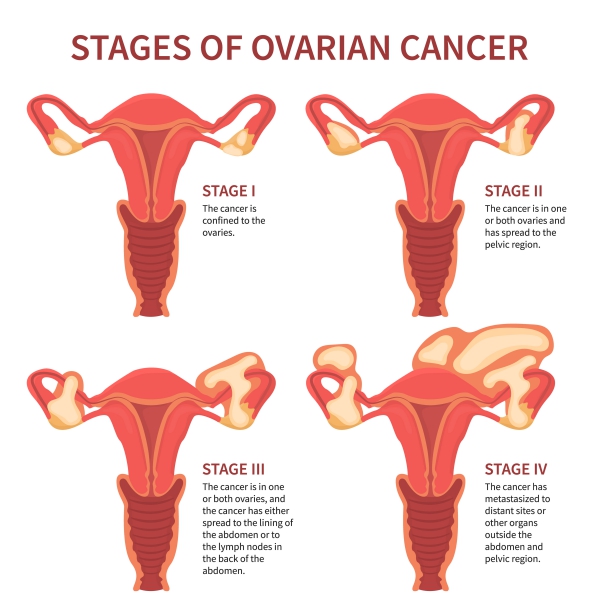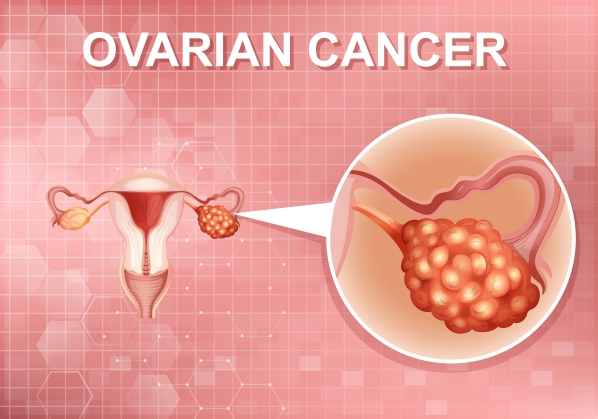What is ovarian cancer?
Ovarian cancer is cancer arising in the female reproductive system, more specifically in the ovaries. The ovaries are a pair of egg-shaped organs found on each side of the uterus and whose function is to secrete hormones, protect females’ eggs and release them for potential fertilization. They are connected to the fallopian tubes through which the eggs travels towards the uterus. In ovarian cancer, the cells present in the ovaries grow out of control and change into abnormal cells.
Ovarian cancer is the most common cause of death from cancer originating in female reproductive organs in the United States. Ovarian cancer may be originating in the ovaries themselves (primary lesions) or may originate from a cancer located somewhere else in the body (secondary lesions). Women aged between 50-65 years are most commonly affected. However, it can occur in women of any age.
It is important to make the diagnosis of ovarian cancer the earlier possible to improve the outcome. There are several treatment options available for ovarian cancer.
What are the causes and risk factors for ovarian cancer?
In ovarian cancer, cells present in your ovaries become abnormal and start to divide uncontrollably. The exact cause for this change is currently unknown. However, it can be caused by mutations in cells that trigger this change.
The following factors can influence the risk of having ovarian cancer:

· Number of children you have: Your risk of having ovarian cancer is higher if you have never had children before. Those who have been pregnant have 50% less risk of ending up with ovarian cancer. You are even more protected against the disease if you had multiple pregnancies.
· Use of oral contraceptives: The use of oral contraceptives has been associated with a decreased risk of having ovarian cancer.
· Family history: You are more at risk of having ovarian cancer if you have a close family member with the same condition.
· History of breast cancer: Women with a history of breast cancer are at higher risk of having ovarian cancer.
· Hormone therapy: Studies have shown that women who are on hormonal therapy are more likely to have ovarian cancer.
· Obesity: Obesity can increase the risk of having ovarian cancer.
· Endometriosis: If you have endometriosis, you are at high risk of having ovarian cancer.
· Use of talcum powder on genitals: Studies have proven that using talcum powder on the vulva can increase the risk of having ovarian cancer.

There are several types of ovarian cancers; epithelial tumours (being the most common), stromal tumours and germ cell tumours.
What are the symptoms of ovarian cancer?
During the initial stages, ovarian cancer may present with no symptoms at all. As the disease progresses, symptoms will start to manifest depending on the extent of the disease. Symptoms may include the following:
· Bloating
· Stomach increasing in size also known as abdominal distension
· Abdominal discomfort
· Constipation
· Bleeding from the vagina
· Indigestion and acid reflux
· Difficulty in breathing
· Fatigue and weakness
· Weight loss
· Feeling full quickly when eating also known as early satiety
· Presence of a mass in the abdomen
· Frequent need to urinate

These symptoms may also be present in other medical conditions. Therefore, if you have the above symptoms it is important to seek medical help in order to confirm what is going on. In cases where ovarian cancer presents without symptoms, the disease may be identified during an ultrasound that was being performed for another reason. This is known as an incidental finding.

Making a diagnosis
Your doctor will start by asking you a variety of questions about your symptoms and general health. He/she will then proceed by performing a physical examination to look for signs and symptoms of ovarian cancer or to rule out other possible diseases. When the diagnosis of ovarian cancer is suspected, other tests may be requested to confirm the diagnosis. These include:
· Blood tests: Blood tests may be requested to check for the general functioning of your organs. There is no specific blood test that can be performed to confirm the diagnosis of ovarian cancer. However, the main test that your doctor may request when suspecting ovarian cancer is the “CA 125” blood test. CA 125 is a protein present in the blood that can increase in the presence of ovarian cancer.
· Imaging tests: Imaging tests such as ultrasound scan, computed tomography (CT) scan and magnetic resonance imaging (MRI) scan may be used to make the diagnosis of ovarian cancer. They allow visualization of structures and organs inside of the body and can identify abnormalities in the ovaries.

· Surgery: The most precise way to make the diagnosis of ovarian cancer is by removing the suspected ovary through surgery and send it for analysis under a microscope. This will help identify whether abnormal cells or growths are present in the organ. If these are present, the doctor will proceed with the surgery to remove as much as possible to treat the cancer.
Screening for ovarian cancer
Screening for ovarian cancer is crucial in women who have the disease but not experiencing any symptoms. Screening in these cases will enable early identification of the disease and initiation of prompt treatment. Screening is done by doing a blood test called the CA 125 blood test, an ultrasound or both the blood and the imaging test.
Screening is recommended in women who are at high risk of having the disease. This include those who:
· Have close family members with the disease
· Carry genes known as the “BRCA” genes
· Have a genetic condition known as Lynch syndrome
How is ovarian cancer treated?
There are different treatment options for ovarian cancer. The choice of treatment depends on various factors including the severity of the disease. Treatment modalities include:

· Surgery: The main treatment for ovarian cancer is surgery. The type of surgery done depends on the extent of the disease. If the cancer is at an early stage and is confined to one ovary, surgery may be done to remove the affected ovary and its associated fallopian tube. This procedure allows you to fall pregnant later. If the cancer is present in both ovaries, the latter will have to be removed with both fallopian tubes. The uterus is left behind, thus, you may get pregnant with the use of frozen embryos or eggs, as well as eggs from a donor. In more severe cases, the cancer may have spread to the uterus. In these cases, ovaries, fallopian tubes, uterus and associated lymph nodes will have to be removed. You lose your ability to have children following this type of surgery.
· Chemotherapy: In some cases, the cancer is so extensive that only surgery may not be sufficient. Therefore, chemotherapy may be used in addition to surgery. This involves the injection of drugs in your veins or into your abdomen to kill cancer cells. These drugs may also be taken orally. Sometimes, chemotherapy may be used prior to a surgery to shrink the cancer.
Prognosis for ovarian cancer
Despite improvements in increasing the 5-year survival rate for ovarian cancer over the last 30 years, the prognosis for ovarian cancer remains poor in general. The outcome is closely related to the stage of the disease at the time of diagnosis.


Source:
Green, A., 2020. Ovarian Cancer: Practice Essentials, Background, Pathophysiology.
Chen, L., and Berek, J., 2020. Epithelial Carcinoma Of The Ovary, Fallopian Tube, And Peritoneum: Clinical Features And Diagnosis.
Carlson, K., 2020. Screening For Ovarian Cancer.






